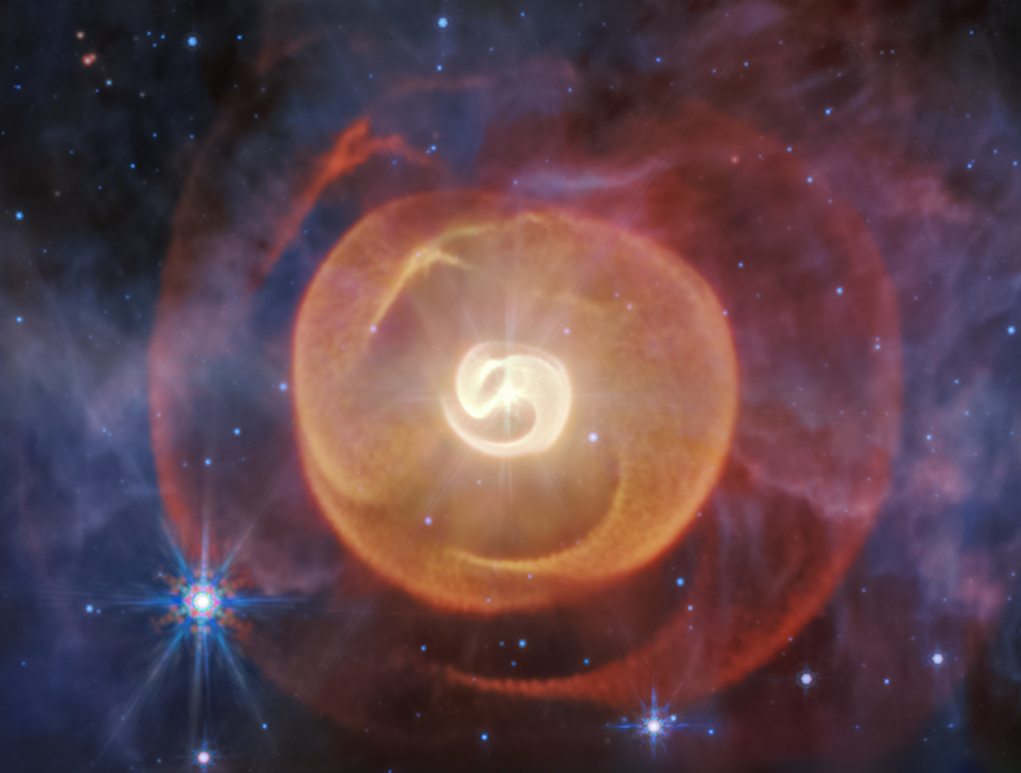Media release
From:
Using NASA's James Webb Space Telescope (JWST) with data from Chile's Very Large Telescope (VLT), an international astronomy team has uncovered extraordinary images of a rare stellar system called Apep, showing four distinct dust shells spiralling outward from three massive stars locked in a cosmic dance.
'Wolf-Rayet' stars are a rare class of massive binary stars, where the earliest carbon in the universe is forged. The discovery helps astronomers understand how these stars interact and evolve over centuries.
A paper by Macquarie University masters student Ryan White, published in The Astrophysical Journal, has refined the orbit of the Wolf-Rayet stars in the Apep system, by combining precise measurements of the ring location from JWST's image with the speed of the shells' expansion from observations taken by the VLT over eight years.
"This is a one-of-a-kind system with an extremely long orbital period," White said. "The next longest orbit for a dusty Wolf-Rayet binary is about 30 years. Most have orbits between two to 10 years."
White's paper was published simultaneously in The Astrophysical Journal with another paper out of Caltech in Pasadena, California, with lead author Dr Yinuo Han.
"Looking at JWST's new observations was like walking into a dark room and switching on the light – everything came into view," said Dr Han.
"There is dust everywhere in JWST's image, and the telescope shows that most of it was cast off in repetitive, predictable structures."
JWST observations delivered a first of its kind: a crisp mid-infrared image of a system of four serpentine spirals of dust, one expanding beyond the next in precisely the same pattern. Ground-based telescopes had only detected one shell before JWST revealed all four.
The JWST image combined with several years of data from the VLT narrowed down how often the pair swing by one another: once every 190 years.
Over each incredibly long orbit, the stars pass closely for 25 years and form dust.
JWST observations also confirmed that there are three stars gravitationally bound to one another in this system. The dust ejected by the two Wolf-Rayet stars is slashed by a third star, a massive supergiant, which carves a hole into each expanding cloud of dust from its wider orbit.
Han, White, and their co-authors refined the Wolf-Rayet stars' orbit by combining precise measurements of the ring location from JWST's image with the speed of the shells' expansion from observations taken by the VLT over eight years.
"JWST gave us the 'smoking gun' to prove the third star is gravitationally bound to this system," Dr Han said.
Researchers have known about the third star since the VLT observed the brightest innermost shell and the stars in 2018, but JWST's observations led to an updated geometric model, clinching the connection.
"We solved several mysteries with JWST," Dr Han said. "The remaining mystery is the precise distance to the stars from Earth, which will require future observations."
The two Wolf-Rayet stars were initially more massive than their supergiant companion, but have shed most of their mass. Eventually, the Wolf-Rayet stars will explode as supernovae, quickly sending their contents into space.
Either may also emit a gamma-ray burst, one of the most powerful events in the universe, before possibly becoming a black hole.
Wolf-Rayet stars are very rare in the universe. Only a thousand are estimated to exist in our Milky Way galaxy, which contains hundreds of billions of stars overall.
Of the few hundred Wolf-Rayet binaries that have been observed to date, Apep (named for the Egyptian god which the dust pattern resembles) is the only example that contains two Wolf-Rayet stars of these types in our galaxy; most only have one.



 Australia; NSW; QLD
Australia; NSW; QLD



